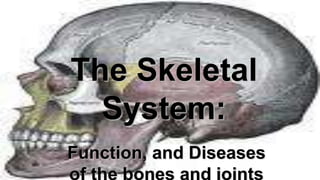
Skeletal System (2).pptx
- 1. The Skeletal System: Function, and Diseases of the bones and joints
- 2. 2 Bones, cartilage and ligaments are tightly joined to form a strong, flexible framework called skeletal system. SKELETAL SYSTEM
- 3. 3 Movement: Skeletal system provides points of attachment for muscles. Your legs and arms move when the muscles pull on the bones. Support: The backbone is the main support center for the upper body. It holds your head up and protects your spinal cord. Functions of the skeletal system
- 4. 4 Protection: The bones of skull protect your brain. Ribs protect your lungs and heart from injury Makes Blood: Red and white blood cells are formed by tissue called marrow, which is in the center of the bone. Storage: Bones store minerals, such as calcium and phosphorus.
- 5. 5 Types of bones Bones can be categorized according to their general shape: long bone short bone flat bone irregular bone
- 6. Classification of Bones on the Basis of Shape Copyright © 2003 Pearson Education, Inc. publishing as Benjamin Cummings Figure 5.1
- 7. 7 1. Provide a framework of the body 2. Give attachment to muscles and tendons 3. Permit movement of the body as a whole and of parts of the body, by forming joints that are moved by muscles. 4. Form the boundaries of the cranial, thoracic and pelvic cavities protecting the organs they contain 5. Contains red bone marrow in which blood cells develop. 6. Provide a reservoir of calcium. Functions of bones
- 8. 8 The bones of skeleton are divided into two groups Axial skeleton- skull, spinal column Appendicular skeleton – limbs and girdle
- 9. 9 Bone Fractures A break in a bone Types of bone fractures
- 10. Simple Fracture • Also called closed fracture • Bone breaks cleanly, and does not penetrate skin. • Little chance of infection
- 11. Compound Fracture • Bone breaks completely • Bone ends protrude through skin • Major chance of serious bone infection • Open fracture
- 12. 12 • If the fracture totally separates the two bones fragments it is called complete • It doesn’t it is called incomplete.
- 13. 13 Comminuted fracture is one in which the bone breaks into more than two fragments.
- 14. 14 Fractures can also be classified according to the direction of the fracture line as • Linear: parallel to the long axis. • Transverse : at right angles to the long axis. • Oblique at an angle other than a right angle to the long axis.
- 15. 15 An incomplete fracture that occurs on the convex side of the curve of a bone is called a green stick fracture.
- 16. Compression Fracture • Bone is crushed • Common in porous bones • Especially common in vertebrae of osteoporosis patients
- 17. Depression fracture • Broken bones are forced inward • Common in skull fractures
- 18. Impacted Fracture • Broken bone ends are forced into each other • Common in falls (ie. From ladder) where person attempts to break their fall
- 19. Spiral Fracture • Occurs from excessive twisting force on bone • Common in sports injuries
- 20. Greenstick Fracture • Bone breaks incompletely • Common in children due to more collagen in bones
- 21. 21 • Bone fractures are treated by reduction and immobilization • Realignment of the bone
- 22. Joints • Any point where bones meet • Also called articulations • Every bone (except hyoid) articulates with at least 1 other bone
- 23. Classifications of Joints • Can be classified by mobility, or by the type of tissue which connects the bones
- 24. Joint classification by Mobility • Can be one of three types. – 1) Synarthroses – immovable joint – 2)amphiarthroses- slightly moveable joint – 3)diarthroses- freely movable
- 25. Classification by connective tissue type • Joints are connected by either fibrous, cartilage, or synovial connective tissue. • Fibrous is usually synarthroses, • Synovial – diarthroses
- 26. Fibrous Joints • Fibrous tissue • Example= sutures of the skull • Tight fibrous tissue allows for essentially no movement
- 27. Cartilaginous Joints • Cartilage • Example= intervertebral joints • Can express either type of movement
- 28. Synovial Joints • Bones separated by synovial cavity • Empty pocket serves to reduce friction between moving bones • Usually located in extremities, where movement is necessary